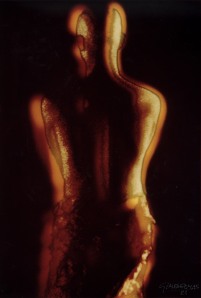1983, el Teatro Principal de Zaragoza programa un espectáculo insólito que hacía referencia a una semilla mítica, Kinkan Shonen, todo el potencial de la vida y de la muerte en torno a la barbarie humana de la explosión nuclear bélica. Allí estuve y lo fotografié.
(english, see below the post)
En su primera gira europea, la compañía japonesa Shankai Juku, ahora ya legendaria, removía las conciencias de Occidente en un espectáculo complejo y cargado de simbolismo en clave oriental. La danza Butoh, teatro moderno de los ’60, denunció la atrocidad y conmovió a Occidente más desde el sentimiento que desde la comprensión.
Dolor y desgarro incomprensiblemente entrelazados con la belleza y el erotismo de unos cuerpos danzantes en ritualidad onírica, caras destrozadas y desfiguradas, máscaras que desenmascaran, dolor compartido, todos uno ante el dolor y la muerte.
Sin entender nada pero embriagado por lo que había visto, conmovido me recreé en el laboratorio fotográfico (el de antes, el de la penumbra y la íntima soledad) en una búsqueda inconsciente de un más allá del plano visual, revelando, desvelando. Fue una larga noche.
Y un incrédulo despertar. La solarización (todavía sin la imagen digital), con un amplio margen para el hallazgo y la casualidad, fue la técnica, fue la táctica que alumbró la oscuridad y realzó lo evidente.
Años después de este encuentro con el teatro Butoh, contraviniendo el orden cronológico, descubrí el antiguo y ancestral Noh, y lo reconocí.
La semilla brotó.
*’click sobre las imágenes para ver más fotos’
José Antonio Giménez Mas
1983, the Teatro Principal in Zaragoza programed an unusual show which referred to a mythical seed, Kinkan Shonen, the full potential of life and death around the human barbarity of war explosion nuclear program. I was there and I photographed it.
In his first European tour, the Japanese company Shankai Juku, now legendary, stirred the Western people awareness by a complex show full of symbolism in Eastern key. Butoh dance, modern theater of the ’60s, denounced the atrocity and touched the West more from feelings than from understanding.
Pain and tear inexplicably intertwined with the beauty and eroticism of dancing bodies in a wonderful ritual, torn and disfigured faces, masks that unmask, shared pain, all one in front of pain and death.
Uncomprehendingly but pervaded of what I had seen, shaked, I concentrated in the photo lab (the earlier, the gloom and the intimate loneliness) in an unconscious search for a beyond visual plane, revealing, unveiling. It was a long night.
And an incredible awakening. Solarization (still without digital image), with a wide margin for the discovery and serendipity, was the technique, was the tactic that illuminated the darkness and enhanced the obvious.
Years after this encounter with the Butoh theater, contravening the chronological order, I discovered the ancient and ancestral Noh, and I recognized it.
The seed sprouted.
Text and translation by José Antonio Giménez Mas



Pingback: Se-pulcro: no-bello | cuaderno de oriente